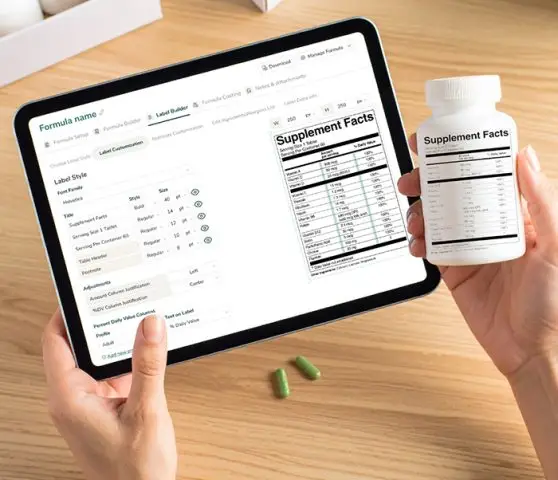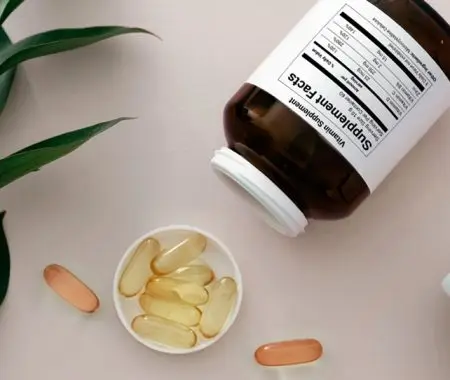What’s the difference between “Supports Immune Health” and “Cures the Flu”?
Getting this line wrong defines your product as either a legal supplement or an illegal drug.
Dietary Supplement Labeling, much like Nutrition Supplement Labeling, has its own set of rules and regulations that food manufacturers need to follow. An important section within these regulations is dedicated entirely to claims, detailing exactly what manufacturers can and cannot say on a supplement label.
This article will give you a clear, step-by-step roadmap to navigate all supplement claim rules, ensuring your label is FDA-compliant.
If you’re unsure of how to get started on your supplements labeling, book a demo to understand how Food Label Maker can fit your specific needs.
Formulate, Analyze, and Generate FDA-Compliant Supplement Labels
What Are the Three Types of Claims the FDA Allows on Dietary Supplements?
There are three categories of claims for both conventional foods and dietary supplements:
- Structure/Function Claims: explains a nutrient or ingredient’s role in the body’s structure or function
- Health Claims: describe a food’s potential health benefits
- Nutrient Content Claims (NCCs): highlight the level of specific nutrients in a product
For the FDA, your product’s claims define its regulatory status. Getting claims right is the core of compliance.
Structure/Function Claims (S/F) – The Most Common
Structure/Function claims describe the role of a nutrient and how it affects the human body. For example: “calcium builds strong bones” or “ fiber maintains bowel regularity”.
According to the FDA a dietary supplement may have a structure/function claim if:
- It’s a benefit against a deficiency-related disease, provided you also state how common that deficiency is in the U.S.
- An ingredient supports, maintains, or affects the normal, healthy structure or function of the human body (e.g., “builds strong bones”).
- It’s a broad statement about improved feelings of health or general well-being (e.g., “promotes general vitality”).
NOTE: It’s important to remember that you must not make a claim about the treatment of diseases, as this is considered a violation of FDA regulations:
✅Good: “Supports healthy cholesterol levels.”
❌Bad (Illegal Drug Claim): “Lowers high cholesterol.”
For any structure/function claim made on your supplement facts label, you must notify the FDA within 30 days of the claim.
The FDA guidelines also state supplement manufacturers must include the following disclaimer text, without modifying any of the wording:
- Singular: “This statement has not been evaluated by the Food and Drug Administration. This product is not intended to diagnose, treat, cure, or prevent any disease.”
- Plural: “These statements have not been evaluated by the Food and Drug Administration. This product is not intended to diagnose, treat, cure, or prevent any disease.”
Health Claims – Needs FDA Approval
Health Claims describe the relationship between a substance and a disease/health-related condition. These claims must be authorized by the FDA and are required to have copious amounts of scientific evidence in order to be made, and before they’re released to market. Because of this, health claims are considered to be significantly harder to attain.
There are two types of health claims:
- Authorized Health Claims: These claims have been reviewed and are fully approved by the FDA based on “significant scientific agreement.” (SSA)
- Qualified Health Claims: These are claims supported by scientific evidence but don’t meet the “significant scientific agreement” standard. The FDA authorizes them with specific wording guidelines, and they must include a statement clearly explaining the lack of scientific agreement.
Some examples of Authorized Health Claims are:
- “Adequate calcium and vitamin D throughout life, as part of a well-balanced diet, may reduce the risk of osteoporosis.” → FDA Regulation 21 CFR 101.72
- “Diets low in saturated fat and cholesterol, and high in fruits, vegetables, and grain products that contain soluble fiber, may reduce the risk of heart disease.” → FDA Regulation 21 CFR 101.81
- “Healthful diets with adequate folate may reduce a woman’s risk of having a child with a brain or spinal cord birth defect.” → FDA Regulation 21 CFR 101.79
- “Diets low in saturated fat and cholesterol that include 25g of soy protein a day may reduce the risk of heart disease.” → FDA Regulation 21 CFR 101.82
Read the FDA’s full list of authorized health claims to ensure your health claim statement would be approved by the regulatory body.
Nutrient Content Claims (NCCs) – Meet Quantitative Standards
Nutrient Content Claims (NCCs) characterize the amount or level of a nutrient contained in a dietary supplement. They are about quantitative math, rather than effects.
Here is a table of the nutrient content claims specifically defined by the FDA with their requirements:
| Nutrient Content Claim | FDA Regulation for Dietary Supplements |
| “High” claims | Contains 20% or more of the Recommended Daily Intake (RDI) or the Dietary Reference Value (DRV) per reference amount customarily consumed (RACC). |
| “Good Source” claims | Contains 10-19% of the RDI or the DRV per reference amount customarily consumed (RACC). |
| “More” claims | Contains at least 10% more of the Daily Value (DV) of the nutrient than the food it is being compared against. |
| “High potency” claims | Used only for vitamins/minerals at 100% or more of the RDI (or 2/3 of vitamins/minerals for multi-products). |
| “Antioxidant” claims | Established RDI Value and “Good Source” (≥10% DV) or “High” (≥20% DV) claim. |
| “Light” or “Lite” claims | Requires either 50% less fat or 1/3 fewer calories than the original version of the product being compared.”Light” and “Lite” claims are exceptionally rare on supplement labels. The reason is simple: these terms are relative claims that require a direct comparison to a “regular” version of the product, which most supplements do not have. |
| “Calorie or Sugar” claims | Terms like “Free” or “Low” require the product to contain a nutritionally insignificant amount based on specific, low FDA thresholds. |
| “Sodium or Salt” claims | “Low Sodium” requires 140mg or less per serving “Sodium Free” requires less than 5mg per serving. |
| “Fat, fatty acids, and cholesterol” claims | Terms like “Free” (e.g., Fat-Free, Saturated Fat Free, Cholesterol-Free) must meet strict, low FDA limits per labeled serving (e.g., <0.5g for Saturated Fat-Free). These claims are often avoided for supplements high in beneficial fats (like fish oils). |
| Implied nutrient content claims | Any word or symbol that suggests a nutrient level (e.g., using “Mega” or a checkmark) must meet the legal definition of the implied claim (like “High” or “Good Source”). |
| “Healthy” claims | Supplements generally do not qualify as this claim is designed for conventional food diets. |
Other than the nutrient content claims listed, a supplement manufacturer or R&D specialist, must use a disclosure statement that warns a consumer if the product exceeds FDA limits for total fat, saturated fat, cholesterol, or sodium.
The limits are:
- Fat – 13g
- Saturated Fat – 4g
- Cholesterol – 60mg
- Sodium – 480mg
Deep Dive: High Potency, Antioxidant, & Percentage Claims
When it comes to nutrition content claims, for dietary supplements, such as potency, antioxidant, and percentage claims – it’s vital that supplement manufacturers get them right. This is because these claims are considered to be more technical and have multiple layers and expectations to meet, on top of the general NCC rules.
High Potency Claims – The 100% Test
A supplement can carry the High Potency Claim if one individual nutrient is present at 100% or more of its Reference Daily Intake (RDI) per serving.
For combination products or botanicals, the claim is only allowed when the product clearly identifies which vitamin, or mineral, is being described. For example: “Botanical X with high potency vitamin E”.
For a multinutrient supplement (i.e. multivitamins), “high potency” can be claimed if the product contains 100% or more of the RDI for at least ⅔ of the nutrients listed. For example: “High potency multivitamin, multimineral dietary supplement tablets”
The FDA strictly regulates “High Potency” because the term often implies a pharmacological effect – a direct, measurable change in the body’s chemistry or function. If misused, these claims can be highly misleading or potentially encourage unsafe dosing. The strict, mathematical FDA standards exist solely to protect consumers and maintain trust.
Antioxidant Claims – The Three Checks
For the claim “Antioxidant” to be true and present, three points must be strictly followed:
- The nutrient must have an established RDI.
- The average daily intake of a nutrient recommended to meet the requirements of 97–98% of healthy individuals in a specific group.
- One exception to this rule is beta-carotene (which does not have an RDI). So, a claim of “good source of antioxidant in beta-carotene” can be made when 10% or more of RDI for vitamin A is present as beta-carotene.
- It has recognized scientific antioxidant activity.
- As defined by the FDA: The ingredient must be scientifically proven to maintain cell integrity by neutralizing free radicals once it is absorbed.
- The dose must qualify for a “Good Source”, “High”, or “More” claim.
- In addition to having recognized antioxidant activity, each nutrient must qualify for either “high”, “good source”, or “more” claims.
- For example: “High in antioxidant vitamin C” means it must contain 20% or more of its RDI.
- For example: “Good source of antioxidant vitamin C” means it must contain 10-19% of its RDI.
Just like the high potency claim, claiming a dietary supplement is an antioxidant could be misleading and harmful to consumers if overused. Therefore, the above strict guidelines are implemented to ensure the claim is only made when it passes the tough regulations.
Percentage Claims – For Non-DV Ingredients
A percentage claim is a statement used for a dietary ingredient that does not have an RDI, DRV, or established Daily Value (DV). If this statement is made, it must have a disclosure statement as well.
There are 2 types of percentage claims:
- Simple Percentage Claim: The percentage of a non-DV ingredient can be added (e.g “40% Curcuminoids”), but it must immediately list the actual amount in milligrams next to it (e.g “40% Curcuminoids, 200mg per capsule”).
- Comparative Percentage Claim: A non-DV ingredient can be compared to a reference product (e.g., “Twice the Omega-3”), but it must clearly identify the reference product and disclose the exact amount of the ingredient in both products.
This rule is exclusive to dietary supplements, as they often have ingredients that do not have an established Daily Value (DV).
Key Differences between Supplement and Food Claims
Labeling for conventional food versus supplements may seem similar in terms of the language used and the layout; however, there are some fundamental differences. A misstep in any compliance regulations for supplements could be very costly! This is why it’s essential for food manufacturers to correctly choose a supplement labeling software that’s knowledgeable and compliant.
The table below summarizes the key differences in labeling regulations between nutrition facts and supplement facts.
| Regulation | Conventional Food | Dietary Supplements |
| Disclaimer Requirement | Not required when making S/F claims | Always required when making S/F claims according to the Dietary Supplement Health and Education Act (DSHEA) of 1994. |
| “Healthy Claim” | Based on food groups (i.e. grains, fruits, vegetables) and limits ‘bad’ nutrients’ (i.e. sodium, saturated foods) | Do not quality since nutrients are very concentrated. |
| Nutrient Content Claims | Usually used to showcase what has been removed (low fat, no added sugar) | Almost exclusively used to showcase what has been added (high potency, good source) |
Final Check: Scientific Evidence is Required
Compliance starts and ends with having scientific proof. Every single claim must be backed by competent and reliable scientific evidence kept, on file, by the manufacturer. If you are challenged by a regulator, this evidence is your only defense.

While the FDA focuses primarily on the physical label and product packaging, the FTC (Federal Trade Commission) monitors all forms of advertising (your website, social media posts, email marketing, etc.). Both agencies require the same level of scientific integrity for any claim you make, meaning your proof must be ready for review at all times.
Conclusion: FDA Dietary Supplement Claims
For any dietary supplement manufacturer, ensuring your label claims are FDA-compliant is a crucial legal step to get the supplement on shelves, legally.
The primary insight is that every claim has a unique regulatory hurdle. Structure/Function Claims demand two things: an FDA disclaimer and notification, and avoiding any language that suggests a cure. Health Claims are the most stringent, requiring extensive scientific evidence and mandatory pre-approval. Finally, NCCs such as “High Potency” are entirely dependent on precise calculation and meeting the FDA’s strict quantitative standards.
Ultimately, regardless of which claim you use, compliance starts and ends with having reliable scientific evidence on file to back up every statement. This proof must be ready for review by the FDA (for labeling) and the FTC (for advertising).
To eliminate the risk of errors, book a demo to see how Food Label Maker automatically verifies your ingredient levels against all the FDA’s strict regulations, guaranteeing a fully FDA-compliant label every time.
Frequently Asked Questions
1. How should the disclosure statement be presented on my supplements label?
The supplements label disclosure statement must be presented in a specific, highly visible format when a nutrient content claim is made that exceeds levels for fat, saturated fat, cholesterol, or sodium (21 CFR 101.13(h)(4)).
The statement must have the following:
- Correct wording: “See nutrition information for [nutrient] content” (e.g., “See nutrition information for fat content”).
- Immediate placement next to the nutrient content claim with no intervening material (like text or graphics).
- Easily legible boldface print in distinct contrast to the rest of the label.
- Font size no less than half the font size of the main claim it is attached to.
If you need help with your disclosure statement, book a demo with our team and one of our experts will guide you through any specific questions you may have.
2. How do I notify the FDA once I make a structure/function claim on my supplements label?
Once you have made relevant structure/function claims on your supplement label, you should follow these steps, according to the FDA regulations:
- Notify FDA within 30 days of first marketing a product whose label or labeling bears a statement made under section 403(r)(6) of the act;
- Submit an original and two copies of the notification to the Office of Nutritional Products, Labeling, and Dietary Supplements (HFS-800), Center for Food Safety and Applied Nutrition, Food and Drug Administration, 5100 Paint Branch Parkway, College Park, MD 20740-3835;
- The notification must be signed by a person who can certify that the information in the notification is complete and accurate, and that the notifying firm has substantiation that the section 403(r)(6) statement is truthful and not misleading.
If you’d prefer not to handle dietary supplement claims on your own, book a demo with Food Label Maker, and a dedicated account manager will be assigned to help you at every step.
3. Who is Food Label Maker’s Supplement Labeling Tool designed for?
If you’re a product developer, R&D scientist, regulatory affairs specialist, quality assurance manager or a nutritionist – this supplements labeling software was designed with you in mind.
The tool is designed in an accurate, compliant and user-friendly way for you to create FDA supplement facts labels with ease and reassurance that it complies with current regulations. It features automated formula builders for scientists, instant compliance verification for regulatory teams, and validation tools crucial for QA managers and nutritionists.
Book a demo today to learn more.
4. How does the Food Label Maker software stay compliant with changing FDA regulations?
We’re always tracking regulatory changes and are constantly updating our software so that your Supplement Facts Label is compliant. Details like formatting changes to new nutrient disclosures are continuously updated so your labels stay compliant by default, reducing the risk of errors or recalls.
To learn more about our Supplements Labeling Software, book a demo today.





